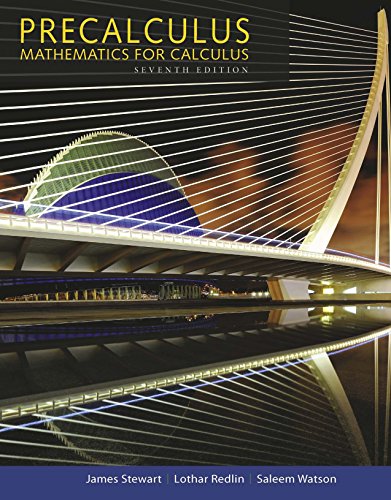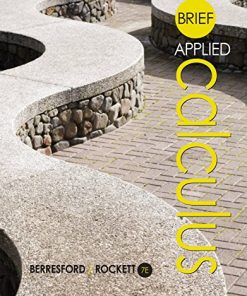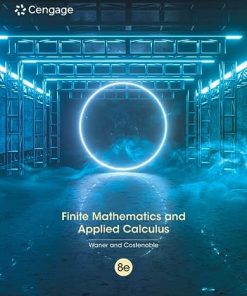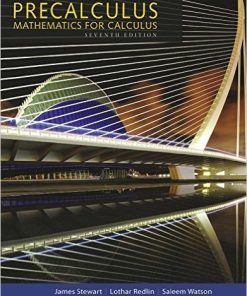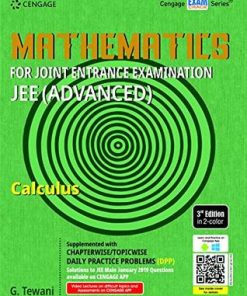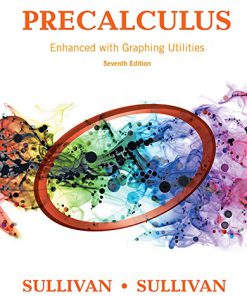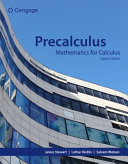Precalculus: Mathematics for Calculus 7th Edition, (Ebook PDF)
$50.00 Original price was: $50.00.$25.00Current price is: $25.00.
Precalculus: Mathematics for Calculus 7th Edition, (Ebook PDF) – Digital Instant Dowload.
Precalculus: Mathematics for Calculus 7th Edition, (Ebook PDF) – Digital Instant Dowload.
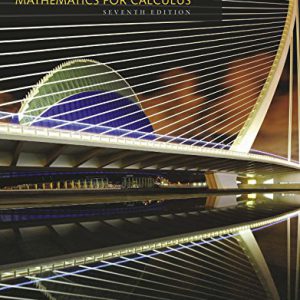
Product details:
- ISBN-10 : 1305115309
- ISBN-13 : 978-1305115309
- Author: James Stewart (Author), Lothar Redlin (Author), Saleem Watson (Author)
This best selling author team explains concepts simply and clearly, without glossing over difficult points. Problem solving and mathematical modeling are introduced early and reinforced throughout, providing students with a solid foundation in the principles of mathematical thinking. Comprehensive and evenly paced, the book provides complete coverage of the function concept, and integrates a significant amount of graphing calculator material to help students develop insight into mathematical ideas. The authors attention to detail and clarity, the same as found in James Stewartsmarket-leading Calculus text, is what makes this text the market leader.
Table contents:
1. FUNDAMENTALS. Chapter Overview. 1.1 Real Numbers. 1.2 Exponents and Radicals. 1.3 Algebraic Expressions. 1.4 Rational Expressions. 1.5 Equations. 1.6 Complex Numbers. 1.7 Modeling with Equations. 1.8 Inequalities. 1.9 The Coordinate Plane; Graphs of Equations; Circles. 1.10 Lines. 1.11 Solving Equations and Inequalities Graphically. 1.12 Modeling Variation. Chapter 1 Review. Chapter 1 Test. FOCUS ON MODELING: FITTING LINES TO DATA.
2. FUNCTIONS. Chapter Overview. 2.1 Functions. 2.2 Graphs of Functions. 2.3 Getting Information from the Graph of a Function. 2.4 Average Rate of Change of a Function. 2.5 Linear Functions and Models. 2.6 Transformations of Functions. 2.7 Combining Functions. 2.8 One-to-One Functions and Their Inverses. Chapter 2 Review. Chapter 2 Test. FOCUS ON MODELING: MODELING WITH FUNCTIONS.
3. POLYNOMIAL AND RATIONAL FUNCTIONS. 3.1 Chapter Overview. 3.2 Quadratic Functions and Models. 3.3 Polynomial Functions and Their Graphs. 3.4 Dividing Polynomials. 3.5 Real Zeros of Polynomials. 3.6 Complex Zeros and the Fundamental Theorem of Algebra. 3.7 Rational Functions. 3.8 Polynomial and Rational Inequalities. Chapter 3 Review. Chapter 3 Test. FOCUS ON MODELING: FITTING POLYNOMIAL CURVES TO DATA.
4. EXPONENTIAL AND LOGARITHMIC FUNCTIONS. Chapter Overview. 4.1 Exponential Functions. 4.2 The Natural Exponential Function. 4.3 Logarithmic Functions. 4.4 Laws of Logarithms. 4.5 Exponential and Logarithmic Equations. 4.6 Modeling with Exponential Functions. 4.7 Logarithmic Scales. Chapter 4 Review. Chapter 4 Test. FOCUS ON MODELING: FITTING EXPONENTIAL AND POWER CURVES TO DATA.
5. TRIGONOMETRIC FUNCTIONS: UNIT CIRCLE APPROACH. Chapter Overview. 5.1 The Unit Circle. 5.2 Trigonometric Functions of Real Numbers. 5.3 Trigonometric Graphs. 5.4 More Trigonometric Graphs. 5.5 Inverse Trigonometric Functions and Their Graphs. 5.6 Modeling Harmonic Motion. Chapter 5 Review. Chapter 5 Test. FOCUS ON MODELING: FITTING SINUSOIDAL CURVES TO DATA.
6. TRIGONOMETRIC FUNCTIONS: RIGHT TRIANGLE APPROACH. Chapter Overview. 6.1 Angle Measure. 6.2 Trigonometry of Right Triangles. 6.3 Trigonometric Functions of Angles. 6.4 Inverse Trigonometric Functions and Triangles. 6.5 The Law of Sines. 6.6 The Law of Cosines. Chapter 6 Review. Chapter 6 Test. FOCUS ON MODELING: SURVEYING.
7. ANALYTIC TRIGONOMETRY. Chapter Overview. 7.1 Trigonometric Identities. 7.2 Addition and Subtraction Formulas. 7.3 Double-Angle, Half-Angle, and Sum-Product Formulas. 7.4 Basic Trigonometric Equations. 7.5 More Trigonometric Equations. Chapter 7 Review. Chapter 7 Test. FOCUS ON MODELING: TRAVELING AND STANDING WAVES.
8. POLAR COORDINATES AND PARAMETRIC EQUATIONS. Chapter Overview. 8.1 Polar Coordinates. 8.2 Graphs of Polar Equations. 8.3 Polar Form of Complex Numbers; DeMoivre’s Theorem. 8.4 Plane Curves and Parametric Equations. Chapter 8 Review. Chapter 8 Test. FOCUS ON MODELING: The Path of a Projectile.
9. VECTORS IN TWO AND THREE DIMENSIONS . Chapter Overview. 9.1 Vectors in Two Dimensions. 9.2 The Dot Product. 9.3 Three -Dimensional Coordinate Geometry. 9.4 Vectors in Three Dimensions. 9.5 The Cross Product. 9.6 Equations of Lines and Planes. Chapter 9 Review. Chapter 9 Test. FOCUS ON MODELING: VECTOR FIELDS.
10. SYSTEMS OF EQUATIONS AND INEQUALITIES. Chapter Overview. 10.1 Systems of Linear Equations in Two Variables. 10.2 Systems of Linear Equations in Several Variables. 10.3 Matrices and Systems of Linear Equations. 10.4 The Algebra of Matrices. 10.5 Inverses of Matrices and Matrix Equations. 10.6 Determinants and Cramer’s Rule. 10.7 Partial Fractions. 10.8 Systems of Non-Linear Equations. 10.9 Systems of Inequalities. Chapter 10 Review. Chapter 10 Test. FOCUS ON MODELING: LINEAR PROGRAMMING.
11. CONIC SECTIONS. Chapter Overview. 11.1 Parabolas. 11.2 Ellipses. 11.3 Hyperbolas. 11.4 Shifted Conics. 11.5 Rotation of Axes. 11.6 Polar Equations of Conics. Chapter 11 Review. Chapter 11 Test. FOCUS ON MODELING: CONICS IN ARCHITECTURE.
12. SEQUENCES AND SERIES. Chapter Overview. 12.1 Sequences and Summation Notation. 12.2 Arithmetic Sequences. 12.3 Geometric Sequences. 12.4 Mathematics of Finance. 12.5 Mathematical Induction. 12.6 The Binomial Theorem. Chapter 12 Review. Chapter 12 Test. FOCUS ON MODELING: MODELING WITH RECURSIVE SEQUENCES.
13. LIMITS: A PREVIEW OF CALCULUS. Chapter Overview. 13.1 Finding Limits Numerically and Graphically. 13.2 Finding Limits Algebraically. 13.3 Tangent Lines and Derivatives. 13.4 Limits at Infinity: Limits of Sequences. Areas. Chapter 13 Review. Chapter 13 Test. FOCUS ON MODELING: INTERPRETATIONS OF AREA. APPENDIX A: Geometry Review. APPENDIX B: Calculations and Significant Figures (available on website). APPENDIX C: Graphing with a Graphing Calculator (available on website). APPENDIX D: Using the TI-83/84 Graphing Calculator (available on website)
You may also like…
Mathematics
Mathematics - Discrete Mathematics
Mathematics - Applied Mathematics
Mathematics - Others
Mathematics for Joint Entrance Examination JEE (Advanced): Calculus G. Tewani
Uncategorized
Mathematics - Algebra


